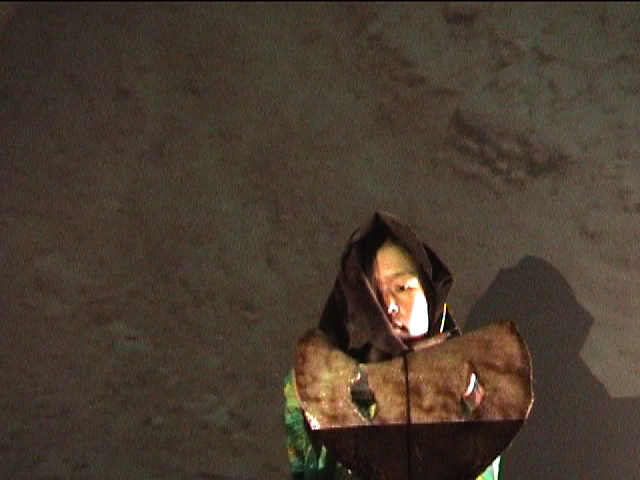Design And Performance Lab
|
Katsura Isobe inside the sand dunes ChoreoDesign Project Suna No Onna
T r e a t m e n t
SUNA NO ONNA is a dance film work featuring three dancers wearing specially designed interactive garments which enable a dynamic relationships to the sand dune environment created in the studio. Inspired by Kobo Abe's novel Suna no Onna (Woman in the Dunes), the choreography is seen through a camera that creates slow-moving poetic scenes of intimacy and sensuous experience of an environment of mysterious entrapment (the sand pit).
The main idea for the proposed work involves artistic experimentation cutting across dance, fashion design, and film to explore new possibilities of material and image transformation in intimate human-computer interaction. The sensorial experience of "wearing" is central to the performance (and the human touch on the digital), as the camera focuses on an inside-outside movement. Touch extends inwards and outwards from the fabrics, the textures, shapes, colours, details and the physical contact with the skin to the intimacy of movement and gesture and of personal exploration through wearing. The film highlights the intimacy in the direct inter-relationship of wearing the garments and the tactile experience of the sand dunes. Outdoor film production will be carried out on location in an abandoned quarry at Goettelborn (Germany); all outdoor shoots will be digitally transferred to a projective environment in the film studio.
The production concept includes specially designed garments which (a) incorporate sensors allowing dancers to move or influence the projective visual environment; and (b) are motion-captured to allow the physical data to transform and animate the nature environment against which the figures move. The slow rhythms of the dancing (performed by Katsura Isobe, Helenn Ren and Olu Taiwo) and the garments-in-motion generate a feeling of continuous transformation, creating deeper resonances of the "ceaseless movement of sand" (Suna no Onna script). Our new wearable designs (SensorDress, ScreenDress, CaptureDress) explore interactive relationship of dress to film. SensorDress combines traditional and sensuous fabrics (silks, leathers, linens etc.) and organic textures with integrated wireless sensor technologies. The sensor data from the bodily and fabric movement are used to activate and edit the landscape projections within the interactive environment. ScreenDress is made from Chromatte, a technical light-reflecting screen cloth for chroma key production affording a dynamic moving canvas for superimposition of motion graphics. CaptureDress allows kinematic data to drive animations and abstract graphic elements in the scenic environment.
Camera movement removes us from one reality into another, one where dance and animation become fused into expressive visual statement: an indissoluble mixture of body, garment and graphic environment. Sound will be generated/re-mixed from the living (outdoor) environment. A particular screen poetics evolves as the body shifts the filmic surface of moving patterns and textures. Our digital treatment is a technological version of the Japanese Body Weather technique and embraces an Eastern view of the body's relation to the environment.
Helenna Ren, spirit of the village of the sand, in movement with bird
Production team: choreography/camera direction (Johannes Birringer), fashion design (Michele Danjoux), dance & choreography (Katsura Isobe, Helenna Ren, Olu Taiwo), motion graphics (Jon Hamilton), sensor programming (Paul Verity Smith), motion capture/animation (Maria Wiener), assistant motion animation (Doros Polydorou) scenography (Hsueh-Pei Wang), sound design (Oded Ben-Tal).
Main production rehersals in July in Interaktionslabor (16-30 July, 2007). Postproduction in October-November 2007 Public premiere of Suna no Onna is planned for late November/early December 2007, in London (UK)
all images from the March rehearsal and software design devopment at DAP Lab Studio and Bitlab (c) 2007 DAP lab
.
Further notes on design and performance concepts are published on this site. (c) dap 2007
Project directors: Johannes Birringer & Michèle Danjoux Brunel University, West London
|

